
Common name:Crape Myrtle
Botanical name:Lagerstroemia indica
The new leaves of this species are 2" long, bright green, and tinged with bronze. Its fall color is affected by the weather. While it has a bare outline, its rounded seed capsules add interest. Its delicate flowers bloom in 6"-12" long clusters. The colors of its flowers are shades of red, rose, pink, purple, and white. It thrives on heat and new cultivars have been created that resist mildew.
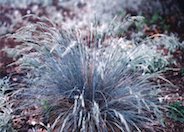
Common name:Superba Fescue
Botanical name:Festuca amethystina 'Superba'
The Rainbow Fescue is a hardy fescue with fine, blue green foliage that grows 8" tall. It has spring flowers that are 12" above the foliage. This fescue is a very showy, neat grass for sunny spots during spring and fall. The Rainbow Fescue is drought tolerant. -Cornflower Farms
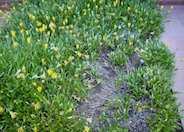
Common name:Moonglow Gazania
Botanical name:Gazania 'Moonglow'
This somewhat hardy perennial will grow 6"-12" high and produces wonderful, bright yellow flowers.
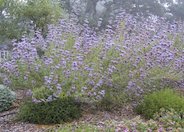
Common name:Winnifred Gilman Dark Blue Sage
Botanical name:Salvia clevelandii 'Winnifred Gilman'
The ' Winifred Gillman' Sage is a dense, compact sub-shrub that grows to 4'-5' tall and wide, and has a round form. It has blue flowers in spikes above the foliage in the spring and summer. This sub-shrub is native to California and is drought tolerant. -Cornflower Farms
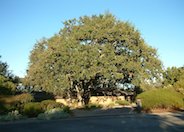
Common name:Coast Live Oak
Botanical name:Quercus agrifolia
The Coast Live Oak is an evergreen round headed tree. It can reach 15'-40' high and 20' wide; it grows very well from the coastal areas to the interior valleys. It is native to California, is drought tolerant, and attracts butterflies. -Cornflower Farms
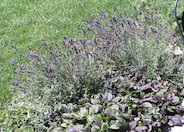
Common name:Hidcote English Lavender
Botanical name:Lavandula angustifolia 'Hidcote'
This is a slow growing lavender that grows to 1' tall with deep purple flowers. It is drought tolerant and attracts hummingbirds and butterflies. -Cornflower Farms
| Designer: Unknown | General Garden Shots 24 |
Photographer: GardenSoft |
Soils and Compost:
Practice grass-cycling by leaving short grass clippings on lawns after mowing, so that nutrients and organic matter are returned to the soil.
Water Saving Tip:
Be sure to fix all leaks promptly no matter how small they may seem.
Integrated Pest Management:
Drip and other smart irrigation delivers water directly to roots, allowing no excess water for weeds.
